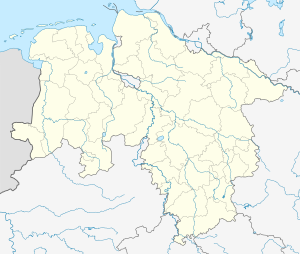Hopfenberg tunnel
| Hopfenberg tunnel | ||
|---|---|---|
| traffic connection | SFS Hannover – Würzburg | |
| length | 728 m | |
| Number of tubes | 1 | |
| Largest coverage | 50 m | |
| construction | ||
| Client | German Federal Railroad | |
| business | ||
| operator | DB network | |
| location | ||
|
|
||
| Coordinates | ||
| North portal | 51 ° 51 ′ 0 ″ N , 9 ° 59 ′ 16 ″ E | |
| South portal | 51 ° 50 ′ 36 " N , 9 ° 59 ′ 14" E | |
The Hopfenberg Tunnel is a 728 m long railway tunnel on the high-speed line from Hanover to Würzburg . The north portal lies on route km 63.429, the south portal at 64.190.
The route crosses the Hopfenberg in the tunnel and therefore bears his name.
course
The route runs straight in the tunnel, the gradient in the tunnel drops over the entire length by 12.4 per thousand to the south. The maximum cover is 50 m.
In its course, the tube crosses layers of shell limestone , essentially layers of middle shell limestone .
A cut up to 21 m deep is in front of the north portal. It is around 150 m above sea level. NN height. Before the transition to the Auetalbrücke to the south , there is a dam.
history
planning
In the planning phase, the tube was largely in the planning approval section 2.12 of the new line. A short section with the south portal (construction kilometers 64,000 and south) belonged to section 2.13.
The tunnel was assigned to construction lot 282.
In 1984 and mid-1986 the planned tunnel length was still 717 m.
construction
The driving work began in April 1986. The tunnel was driven from south to north in an upward direction using the mining method. It passes through different layers of the upper , middle and lower shell limestone .
In October 1986, up to 50 m long and 5 m high karst caves were discovered while driving and filled with concrete. When passing through layers of the Middle Muschelkalk , ridge settlements of up to 20 cm occurred, which made it necessary to switch to rapid ring closure .
Together with the neighboring Helleberg and Wadenberg tunnels , 365,000 m³ of tunnels were excavated, and 515,000 m³ of earth was removed in the pre- cuts. A total of 85,000 m³ of concrete and 2,900 t of steel were used. The construction cost for the three tubes was 90 million D-Marks (around 45 million euros ).
The tunneling work ended one year after the tunneling began.
Web links
- Pictures of the tunnel portals and report on a construction site excursion (1986) on eisenbahn-tunnelportale.de
Individual evidence
- ↑ a b c d e Deutsche Bundesbahn, Bundesbahndirektion Hannover, project group Hannover – Würzburg North of the railway construction center: Tunnel construction in the northern section of the new Hanover – Würzburg line , brochure (22 pages), status: January 1987, p. 11.
- ↑ a b c d Heinz Duddeck, Horst Geißler, Friedrich Schrewe: Tunnel construction in sinkhole areas . In: Peter Koch, Rolf Kracke, Theo Rahn (eds.): Engineering structures on the new lines of the German Federal Railroad . Hestra-Verlag, year, ISBN 3-7771-0240-7 ( Archives for Railway Technology . Volume 44), p. 158.
- ↑ a b c d e DB project group Hanover-Würzburg (North) (ed.): Billerbeck, Haieshausen, Opperhausen , twelve-page leporello dated July 1, 1984.
- ↑ a b c DB, project group Hanover – Würzburg (North) (ed.): New Hanover-Würzburg line: Kreiensen, Orxhausen, Bentierorde, Billerbeck . Twelve-page fanfold dated July 1, 1984.
- ^ Deutsche Bundesbahn, project group Hanover – Würzburg North of the Federal Railway Directorate Hanover: The new Hanover – Würzburg line. The Hanover – Northeim section . Brochure (43 pages) from 1984, p. 36.
- ^ Deutsche Bundesbahn (Ed.): Route map of the new Hanover – Würzburg line. Hanover – Northeim section . Map from June 1986.
- ^ Project group NBS Hanover of the Bahnbauzentrale, Bundesbahndirektion Hanover (ed.): Tunnel construction in the northern section of the new Hanover - Würzburg line . Brochure as of November 1987, p. 13.
